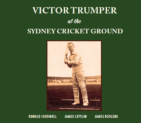A Striking Summer
Martin Chandler |Published: 2024
Pages: 255
Author: Brenkley, Stephen
Publisher: Fairfield Books
Rating: 5 stars

I had planned to start this review with a complaint, that being that author Stephen Brenkley, whose writing for The Independent I always enjoyed as well as his contribution to the now sadly (I believe) defunct Cricket Writers on TV programme on Sky, had never written a book before.
Fortunately for me before I posted this I thought I’d better check that one out, and it was a good job I did, as it seems that not only has Brenkley gone into print at least once before, but that that was a cricket book as well. I shall have to seek out a copy of Small Town, Big Dreams, not because books about club cricket are really my thing, but because if it is anything like as good as A Striking Summer it will at least enable positive thoughts to come into my head at the mention of Barnard Castle, rather than the wholly negative picture any mention of the Durham town has conjured up in my mind ever since that infamous lockdown incident in 2020.
But despite that the point remains a good one. Brenkley has put together a fine book in A Striking Summer, and now he is no longer the cricket correspondent of The Independent he will hopefully have some free time in which to revisit some other far off staging post in the long history that Test cricket enjoys.
For A Striking Summer Brenkley has stopped off in 1926, so almost a century ago now. In an Ashes summer Tests one to four were all drawn. Two were ruined by rain and the good cricket played in the other two was, in terms of results at least, frustrated by the matches only being scheduled for three days each. In the circumstances the final Test at the Oval was to be played to a finish and one of the great Test matches saw what was ultimately a comfortable England victory, the best remembered contribution to which was the remarkable opening partnership in England’s second innings by Jack Hobbs and Herbert Sutcliffe.
The series was the subject of a contemporary account by former England captain ‘Plum’ Warner, and another by his Australian counterpart Monty Noble. One of the interesting aspects of the tour was Warner’s double role of reporter and chronicler as well as selector. And if that weren’t enough another selector and former England Ashes skipper Arthur Gilligan also wrote an account of the series. A further book by John Marchant was concerned only with the final Test, a sure sign of its importance and the interest it generated.
And there was certainly plenty of interest in what went on in the England selectors’ meetings. The recall of one of their number for the Oval, 49 year old Wilfred Rhodes was one aspect of that, but even that paled into comparative insignificance when set against the travails of England captain Arthur Carr, and the manner in which he was replaced for the Oval with Percy Chapman.
Over the next few years much more was written about the 1926 series. Of the England side all of Tate, Hendren, Woolley, Root, Hobbs, Sutcliffe and Larwood went into print at various times, and if only Macartney of the Australians did there are only a handful of men on either side who have not been the subject of biographies. Inevitably therefore much information on what went on in the series came to light only after the contemporary accounts were published, making a fresh look at the 1926 Ashes a thoroughly worthwhile project on cricketing grounds alone.
However there is a great deal more to A Striking Summer than five Test matches against Australia. 1926 was the year of the General Strike, and a battle fought between the Conservative Government of the day and the in those days private owners of the collieries on the one hand, and the mineworkers on the other. For nine days in May the miners were supported in a general strike by other members of the Trade Union Congress.
I began the book well knowing that it weaved the story of the strike and the general unrest in industrial Britain with the unfolding and unifying pursuit of the regaining of the Ashes. The strike was an episode in twentieth century history that I thought I knew pretty well. In the event however I soon realised that was not the case. I did know that the miners had, ultimately, been forced to back down, but I did not realise just how badly they were treated and, as a result of reading A Striking Summer, have a much greater understanding now of the background to two events I have lived through, the Winter of Discontent of 1978/79, and the Battle of Orgreave in 1984.
Conceding at the outset that the inter war period is one that I have always found of particular interest, both for cricketing and social history, this is still a truly outstanding book, and one which I recommend without the slightest hesitation.






Leave a comment